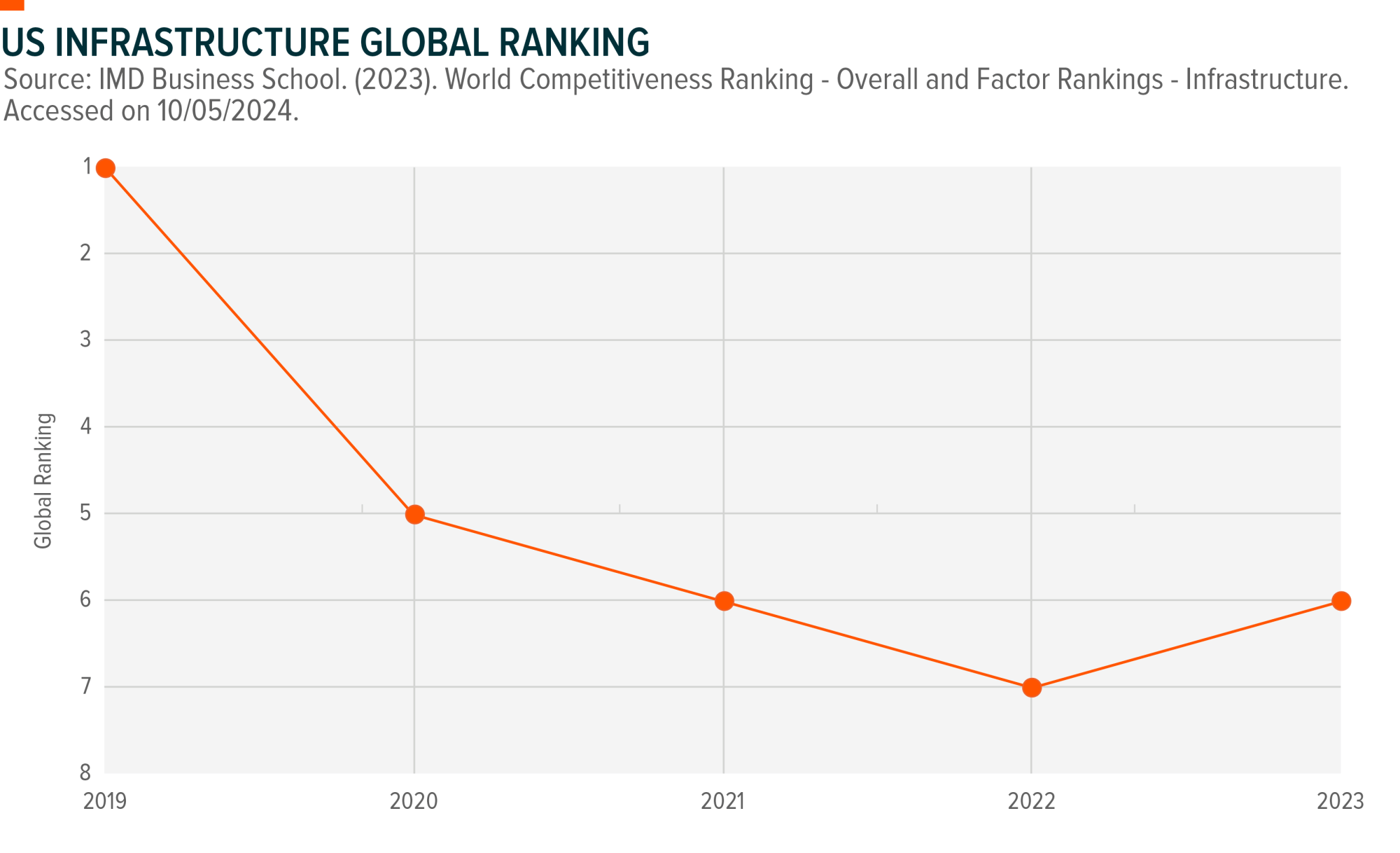The Resurgence of US Infrastructure



Infrastructure is one of the backbones of economic prosperity and societal well-being, and here, in the 21st century, it has never been more crucial.
As the world grapples with unprecedented challenges—from rapid urbanisation and climate change to technological disruption—modern, resilient infrastructure systems are vital for sustainable development. Furthermore, consequences of geopolitical tension have driven a trend of deglobalisation, reshaping future infrastructure development and providing new, government-backed, opportunities for investors to capitalise upon.
The State of the States
Despite being the world’s leading economy, the US’s outdated infrastructure assets are in dire need of a 21st century overhaul, evidenced by the country’s continually declining global ranking in infrastructure. 1

According to the World Infrastructure Hub, the US currently requires at least US$3.8 trillion in additional investment to adequately repair existing infrastructure and keep pace with economic expansion. 2 This figure marks the largest single country infrastructure investment gap in the world. 3
Much of that shortfall is attributed to the expansive nature of the country combined with the cumulative lack of investment. While spending on infrastructure construction has nominally increased at an annualised rate of 4.5% over the last 22 years, 4 it has actually decreased at an annualised rate of -2.5% once controlling for inflation and real GDP growth. 5

As a result of this low level of investment, the US’s infrastructure assets including airports, ports, roads, and bridges all require significant enhancements. The American Society of Civil Engineers gave America’s infrastructure a “C-“ on its quadrennial ‘Report Card’ in 2021, and graded US roads a “D,” bridges a “C,” airports a “D+,” and ports a “B-,” noting that the country is “badly in need of greater investment in infrastructure”. 6
Another, rather bleak driver of US infrastructure spending is the growingly common occurrence of natural disasters thanks to climate change. In 2023, the US experienced a record-breaking 28 weather and climate disasters, each costing more than a billion USD. 7 Those natural disasters cost the country roughly US$92B in total - which when added to the running sum of disaster costs in the US since 1980, comes to a shocking number that exceeds US$2.6 trillion. 8

More resilient infrastructure could vastly reduce these costs. For physical infrastructure, this means focusing on architecture, engineering, and planning. Traditional enhancements like raised roadbeds, proper drainage systems, and strengthened levies and sea walls, can all help protect infrastructure and property during extreme weather events. Luckily, some of these efforts are already underway: a 2020 survey of the 50 largest US cities found that more than 240 infrastructure resilience projects were in the pipeline, totalling US$47 billion in investments, of which ~60% are for managing flood risk. 9 More recently, the Biden-Harris administration announced nearly US$830 million in grants for 80 infrastructure resilience projects that would secure transportation and evacuation routes in the event of natural disasters. 10
A Shift Driven By Policy
Passed in late 2021, the Infrastructure Investment and Jobs Act (IIJA) was considered by many to be a major step toward rebuilding America’s infrastructure. The bill contained US$550 billion in new appropriations through to 2030, of which roughly US$270 billion was allocated to transportation, US$90 billion to clean energy projects, and US$85 billion to water infrastructure and environmental remediation. 11 In early November 2023, the Biden Administration reported that US$400 billion of the fund had been announced, spread across 40,000 projects at the state level. However, most projects in the tally remain in the planning stages with several more steps needed before construction can begin. Therefore, we expect much of the investment to occur over the next few years, with the total thus far representing only a subset of what is to come. Still, many projects are moving forward already thanks to the bill. So far, the IIJA helped launch 7,800 bridge repair projects, jumpstarted renovation on 135,800 miles of roads, and funded 190 airport modernisation efforts. 12
Apart from the introduction of the IIJA, the Inflation Reduction Act (IRA) and Creating Helpful Incentives to Produce Semiconductors (CHIPS) Act are two further initiatives that the US parliament have passed into law. While neither act is specifically designated to infrastructure spending, both seek to bolster US competitiveness in disruptive technologies. As such, we expect the packages will encourage the build-out of manufacturing capacity, distribution networks, and other domestic supply chain assets – leading naturally to investment in infrastructure development.
Federal spending is also encouraging the private sector to act. Since the CHIPS Act and IRA passed in August 2022, private funding for areas like semiconductors, clean power and equipment, and EVs and batteries totalled US$577 billion as of November 2023. 13 In this sense, the enormous topline numbers for these bills actually understate the magnitude of funding that could impact the U.S. infrastructure space over the next several years.
How Does the Global X US Infrastructure Development ETF (PAVE) Approach Infrastructure Investing?
Many approaches to investing in infrastructure tend to focus on the owners and operators of existing infrastructure assets, rather than on the companies that derive a significant portion of their revenues from building or maintaining infrastructure assets.
For example, over 90% of the US companies in the S&P Global Infrastructure Index are utilities and energy companies that own or operate infrastructure assets. 14 While these companies do make investments to maintain and develop infrastructure, they potentially stand to benefit from only a minor portion of total infrastructure spending in the US.
Instead of focusing on companies that operate existing infrastructure assets, PAVE is designed to provide exposure to companies that can derive additional revenues from increased spending on both publicly and privately funded infrastructure projects, stand to earn these additional revenues regardless of whether the project is maintenance of existing assets or developing new infrastructure, and can collect these revenues years before the projects are completed. These companies include those involved in the construction and engineering of infrastructure projects, the production of raw materials, composites and products used in building infrastructure projects, producers and distributors of heavy construction equipment, and companies engaged in the transportation of materials used in infrastructure projects. It must be noted PAVE’s targeted approach may expose investors to sector concentration risk and is designed to be used as a satellite holding as a part of a well-diversified portfolio.

1 IMD Business School. (2023). World Competitiveness Ranking - Overall and Factor Rankings - Infrastructure. Accessed on 10/05/2024.
2 Global X ETFs. (March 30, 2023). Thematic Investing Whitepaper: Infrastructure Development.
3 Global X ETFs. (March 30, 2023). Thematic Investing Whitepaper: Infrastructure Development.
4 Global X ETFs using data from U.S. Census Bureau. (n.d.) Based on 2023 Construction Spending Survey. Dataset starts in 2002.
5 Global X ETFs using data from U.S. Census Bureau. (May 17, 2024). Based on 2023 Construction Spending Survey.
6 ASCE. (n.d.) Report Card For America’s Infrastructure.
7 Climate.gov. (January 8, 2024). 2023: A historic year of U.S. billion-dollar weather and climate disasters.
8 Ibid
9 Moody’s. (January 17, 2019). Largest US cities take proactive steps to mitigate credit risk from climate change.
10 US Department of Transportation. (April 11, 2024). Biden-Harris Administration Announces Nearly $830 Million in Grants to Make Transportation Infrastructure More Resilient to Climate Change.
11 Global X ETFs. (November 11, 2021). Congress Passed the Infrastructure Investment & Jobs Act. What Does This Mean for Investors?
12 The White House. (2023, November 9). FACT SHEET: Biden-Harris Administration Celebrates Historic Progress in Rebuilding America Ahead of Two-Year Anniversary of Bipartisan Infrastructure Law.
13 The White House. (2023, November). Investing in America.
14 Bloomberg. (n.d.) Accessed on 17/05/2024.
Disclaimer:
This document is issued by Global X Management (AUS) Limited (“Global X”) (Australian Financial Services Licence Number 466778, ACN 150 433 828) and Global X is solely responsible for its issue. This document may not be reproduced, distributed or published by any recipient for any purpose. Under no circumstances is this document to be used or considered as an offer to sell, or a solicitation of an offer to buy, any securities, investments or other financial instruments. Offers of interests in any retail product will only be made in, or accompanied by, a Product Disclosure Statement (PDS) which is available at www.globalxetfs.com.au. In respect of each retail product, Global X has prepared a target market determination (TMD) which describes the type of customers who the relevant retail product is likely to be appropriate for. The TMD also specifies distribution conditions and restrictions that will help ensure the relevant product is likely to reach customers in the target market. Each TMD is available at www.globalxetfs.com.au.
The information provided in this document is general in nature only and does not take into account your personal objectives, financial situations or needs. Before acting on any information in this document, you should consider the appropriateness of the information having regard to your objectives, financial situation or needs and consider seeking independent financial, legal, tax and other relevant advice having regard to your particular circumstances. Any investment decision should only be made after obtaining and considering the relevant PDS and TMD.
This document has been prepared by Global X from sources which Global X believes to be correct. However, none of Global X, the group of companies which Mirae Asset Global Investments Co., Ltd is the parent or their related entities, nor any of their respective directors, employees or agents make any representation or warranty as to, or assume any responsibility for the accuracy or completeness of, or any errors or omissions in, any information or statement of opinion contained in this document or in any accompanying, previous or subsequent material or presentation. To the maximum extent permitted by law, Global X and each of those persons disclaim all any responsibility or liability for any loss or damage which may be suffered by any person relying upon any information contained in, or any omissions from, this document.
Investments in any product issued by Global X are subject to investment risk, including possible delays in repayment and loss of income and principal invested. None of Global X, the group of companies of which Mirae Asset Global Investments Co., Ltd is the parent, or their related entities, nor any respective directors, employees or agents guarantees the performance of any products issued by Global X or the repayment of capital or any particular rate of return therefrom.
The value or return of an investment will fluctuate and an investor may lose some or all of their investment. All fees and costs are inclusive of GST and net of any applicable input tax credits and reduced input tax credits, and are shown without any other adjustment in relation to any tax deduction available to Global X. Past performance is not a reliable indicator of future performance.
Forecasts are not guaranteed and undue reliance should not be placed on them. This information is based on views held by Global X as at 27/05/2024. Past performance is not a reliable indicator of future performance.
Diversification does not ensure a profit nor guarantee against a loss. Brokerage commissions will reduce returns. This material represents an assessment of the market environment at a specific point in time and is not intended to be a forecast of future events, or a guarantee of future results.

Global X is a leading ETF provider, offering a wide range of thematic, commodities, income, core, and digital asset solu...
Recommended for you
One of the most significant surprises of 2024 was the plan announced by the Australian Prudential Regulation Authority’s (APRA) to phase out AT1 hybrids issued by banks. This change raises a number of questions, the most pressing of which is what will happen to AT1 hybrids in 2025 and 2026? Fixed income investors would be wise to start planning how best to navigate the road ahead.
The recent US election has had strong reverberations across equity markets internationally and in Australia. Here, Tynda...
The growing use of drones is transforming warfare
Innovation isn’t just a buzzword; it’s the lifeblood of growth, competitiveness, and sustainability across industries.

















